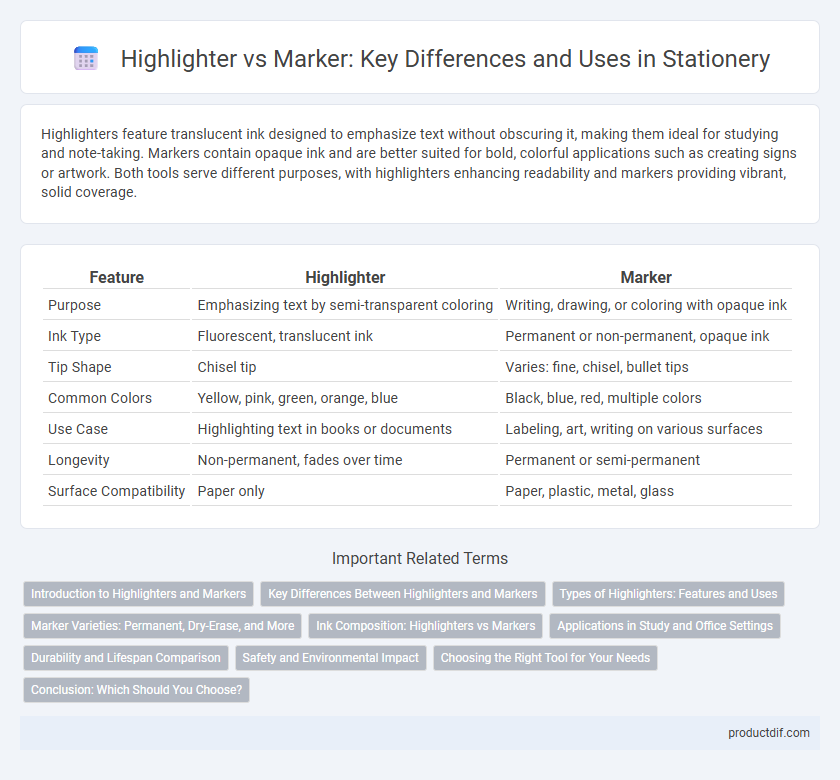Highlighters feature translucent ink designed to emphasize text without obscuring it, making them ideal for studying and note-taking. Markers contain opaque ink and are better suited for bold, colorful applications such as creating signs or artwork. Both tools serve different purposes, with highlighters enhancing readability and markers providing vibrant, solid coverage.
Table of Comparison
| Feature | Highlighter | Marker |
|---|---|---|
| Purpose | Emphasizing text by semi-transparent coloring | Writing, drawing, or coloring with opaque ink |
| Ink Type | Fluorescent, translucent ink | Permanent or non-permanent, opaque ink |
| Tip Shape | Chisel tip | Varies: fine, chisel, bullet tips |
| Common Colors | Yellow, pink, green, orange, blue | Black, blue, red, multiple colors |
| Use Case | Highlighting text in books or documents | Labeling, art, writing on various surfaces |
| Longevity | Non-permanent, fades over time | Permanent or semi-permanent |
| Surface Compatibility | Paper only | Paper, plastic, metal, glass |
Introduction to Highlighters and Markers
Highlighters and markers serve distinct purposes in stationery, with highlighters designed to emphasize text using translucent, fluorescent ink that enhances readability without obscuring the original content. Markers typically feature opaque, vibrant ink suitable for bold writing, drawing, and labeling on various surfaces, including paper, whiteboards, and plastics. Both tools come in diverse tip shapes and sizes, catering to specific tasks like fine detailing or broad coverage in office, school, and artistic settings.
Key Differences Between Highlighters and Markers
Highlighters are designed with translucent, fluorescent ink that emphasizes text without obscuring it, making them ideal for reading and studying, whereas markers feature opaque, pigmented ink suited for bold, vibrant marking on various surfaces. The tips of highlighters are typically chisel-shaped to allow broad and fine lines, while markers come in diverse tip styles including fine, medium, and brush tips for versatile art and labeling purposes. Highlighters primarily use water-based ink to prevent bleeding through paper, in contrast to markers that often use solvent-based ink, which provides richer colors but may bleed and is better suited for non-porous surfaces.
Types of Highlighters: Features and Uses
Highlighters come in various types including fluorescent, pastel, and gel, each designed to enhance text visibility without obscuring content, making them ideal for studying and note-taking. Fluorescent highlighters provide bright, vivid colors that stand out on paper, while pastel highlighters offer softer hues suitable for aesthetic layouts and detailed work. Gel highlighters use unique ink that resists smudging and bleeding, perfect for use on thinner paper or in planners.
Marker Varieties: Permanent, Dry-Erase, and More
Markers come in various types, including permanent markers designed for long-lasting writing on surfaces like plastic, metal, and glass, and dry-erase markers suitable for whiteboards that allow easy erasing. Other varieties include water-based markers used for children's art projects and paint markers that provide opaque, vibrant colors on multiple surfaces. Each type serves distinct purposes based on their ink formulation, durability, and surface compatibility.
Ink Composition: Highlighters vs Markers
Highlighters typically use fluorescent, water-based ink designed to be translucent and non-permanent, allowing underlying text to remain visible without smudging. Markers often contain pigment-based or solvent-based ink that is more opaque, permanent, and suitable for writing on various surfaces like paper, plastic, and metal. The ink composition directly affects drying time, bleed-through, and application purposes, distinguishing highlighters from markers in functionality and usability.
Applications in Study and Office Settings
Highlighters are designed with translucent ink ideal for emphasizing textbooks and notes without obscuring text, making them essential for study applications. Markers offer more vivid, opaque colors suited for bold writing and labeling on diverse office surfaces such as whiteboards, files, and packaging. The choice between highlighters and markers depends on whether clarity in reading or visibility in marking is prioritized in study or office environments.
Durability and Lifespan Comparison
Highlighters generally feature ink formulated for quick drying and resistance to smudging, resulting in moderate durability suited for paper annotation, while markers offer broader ink types, including permanent variants that provide extended lifespan and stronger resistance to fading on diverse surfaces. The durability of markers often surpasses highlighters due to their ink density and waterproof properties, making markers ideal for long-term labeling and artistic projects. Highlighter ink tends to fade faster with exposure to light and frequent handling, whereas markers maintain color vibrancy and legibility over prolonged periods.
Safety and Environmental Impact
Highlighters typically contain water-based or low-odor fluorescent dyes, making them safer for indoor use and less harmful to the environment compared to markers, which often use solvent-based inks with volatile organic compounds (VOCs). Markers may pose health risks due to fumes and contribute to environmental pollution when disposed of improperly, whereas many highlighters are now designed with non-toxic, eco-friendly materials and refillable options. Choosing certified non-toxic highlighters over traditional markers reduces exposure to harmful chemicals and supports sustainable stationery practices.
Choosing the Right Tool for Your Needs
Highlighters are designed with translucent ink to emphasize text without obscuring readability, ideal for studying and note-taking. Markers offer opaque and vibrant colors suitable for bold labeling, artwork, or writing on non-paper surfaces. Selecting the right tool depends on the purpose: use highlighters for subtle emphasis on documents and markers for strong, visible marks on various materials.
Conclusion: Which Should You Choose?
Highlighters are ideal for emphasizing text with translucent colors that won't obscure underlying words, making them perfect for studying or annotating documents. Markers offer bold, opaque lines suited for labeling, drawing, or creating vibrant artwork on various surfaces. Choose highlighters for clarity in reading and markers for visibility and creative expression.
Highlighter vs Marker Infographic

 productdif.com
productdif.com